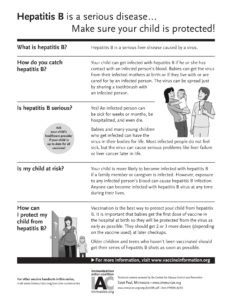JANUARY 2019
National Blood Donor Month
Millions — including cancer patients, organ recipients, and accident victims – count on blood being at the ready. Every two seconds someone in the U.S. needs blood, according to the American Red Cross.
Approximately 36,000 units of red blood cells and 7,000 units of platelets are needed every day in the U.S.
Type O is the blood type most often requested by hospitals. Type O negative blood (red cells) can be transfused to patients of all blood types. It’s always in great demand and often in short supply. Only 7% of people in the U.S. have type O negative blood.
AB positive blood donors are universal donors of plasma. Only 3% of people in the U.S. have AB positive blood.
A single car accident victim can require
as many as 100 pints of blood.
Blood donation is a simple four-step process: registration, medical history, and mini-physical, donation, and refreshments. Donating blood is a safe process. A sterile needle is used only once for each donor and then discarded.
The actual blood donation typically takes less than 10-12 minutes. The entire process, from the time you arrive to the time you leave, takes about an hour and 15 minutes.
A single donation can potentially help more than one patient.
Five health benefits from donating blood:
Free blood tests – donated blood is tested and a donor can ask to be
informed if any irregularities are found.
Satisfaction of saving human lives
Calorie burn – Blood donation process burns 650 calories – about the same as an average spin class!
Reduced risk of heart disease – helps eliminate the excess buildup of iron in the blood
Reduced risk of cancer – also due to the reduction of excess iron buildup in
the blood
Blood donation appointments can be made by downloading the American Red Cross Blood Donor App, visiting redcrossblood.org or calling 1-800-RED CROSS (1-800-733-2767) to make an appointment or to receive more information. All blood types are needed to ensure a reliable supply for
patients.
A blood donor card or driver’s license or two other forms of identification are required at check-in. Individuals who are 17 years of age (16 with parental consent in some states), weigh at least 110 pounds and are in generally good health may be eligible to donate blood.
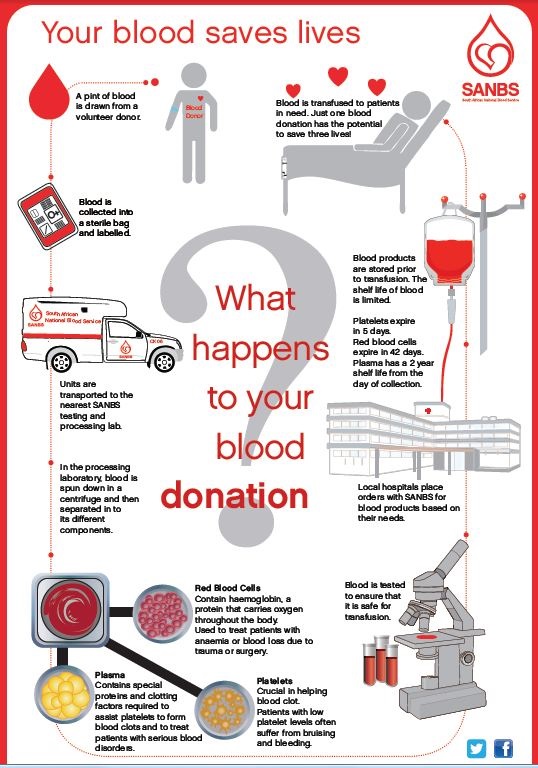
FEBRUARY 2019
Age-Related Macular Degeneration (AMD) Awareness
What is Age-related
macular degeneration (ARMD)?
ARMD is a disorder of the macula. The macula is the part of your retina where your central and color vision comes from. ARMD is a complex disorder where degenerative protein/lipids (called “drusen”) deposit under the retina. These deposits are seen in early macular degeneration. As the disease progresses, the structural support system of the retina breaks down and can allow abnormal blood vessels to grow, or leak fluid and further disrupt the retinal cells. If these blood vessels grow in the macula, then you will lose your central. (There are other types of macular degeneration and drusen deposits that are not related to ARMD so a complete eye exam by an eye doctor for diagnosis is recommended.)
Risk Factors include:
Age: Affects more than 2 million Americans over 50 years old. Prevalence of ARMD in the USA is around 6% when 65 and almost 20% when 75 years old.
Genetics: Family history
Smoking: Increases your risk for progression
Other eye conditions: hyperopia and light colored iris
Systemic diseases associated: hypertension, hypercholesterolemia, cardiovascular disease
Gender: women are more likely to be affected than men
What is the treatment?
One of the mainstays of treatment is 1) quitting smoking and 2) AREDS vitamins. The Age-Related Eye Disease Study (AREDS) proved that certain vitamins can decrease your risk of progressing to advanced forms of macular degeneration if you have early to intermediate disease by 25% over 5-10 years.
Specifically, these vitamins are Vitamin C 500 mg daily, Vitamin E 400 IU daily, Beta-carotene 15 mg (25,000 IU) daily, Zinc oxide 80 mg daily and Cupric oxide 2 mg daily.
Injections of medications into the affected eye.
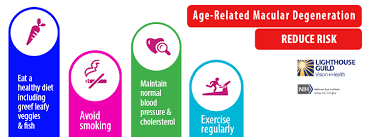
MARCH 2019
National Nutrition Month
National Nutrition Month is an annual nutrition education and information campaign created by the Academy of Nutrition and Dietetics
The campaign focuses attention on the importance of making informed food choices and developing sound eating and physical activity habits.
The theme this year is “Bite Into a Healthy Lifestyle.” Feeling inspired but not sure where to start?
Tips to bite into a healthy lifestyle:
Learn your needs. Age, gender, body type, family history, existing health conditions and daily routines all play a factor in determining which foods to eat more of and which ones to avoid. Knowing which foods contain the nutrients you need is the next step in biting into a healthy lifestyle.
Know the facts. When food selections go beyond whole foods and into packaged foods, the ingredient list and Nutrition Facts Panel can be useful tools to help make more informed choices. The higher an ingredient is on the list, the more of that ingredient is included compared to others. This is a good way to determine if a product is made with whole grains, or has a lot of added sugars. Regardless of nutrition claims on the front of the package, it’s important to read the Nutrition Facts Panel to determine how many calories and how much fat, sugar and salt are in the package.
Plan your snacks. Keep a variety of tasty, nutritious, ready-to-eat foods nearby. This will help reduce the temptation to eat less healthy options from vending machines, convenience stores, or the break room. Healthy snack ideas include fresh fruit, air-popped popcorn, whole-wheat crackers, dried fruit and nut mixes, almonds and low-fat yogurt. Think of snacks as mini-meals to help you eat more fruits, vegetables, whole grains, and low-fat dairy. Remember to snack only when hungry, not out of boredom, stress, or frustration.
Regular physical activity is a must. Daily physical activity is an important part of a healthy lifestyle, but unfortunately, most don’t include enough movement in daily routines. Regular physical activity strengthens bones and muscles, reduces the risk of chronic illness, and fosters overall well-being, which included stress relief, higher quality sleep, and a more positive mental outlook.
Everyday ways to get moving. Physical activity is important for everyone at every age. The key is to find activities that are enjoyable and can easily be maintained. Here are some tips for everyday ways to get moving. Try using the buddy system, joining a walking group or attending fitness classes. Sign up for a 5k run/walk with friends or family. Sneak in exercise at your desk or buy a desk that allows you to stand while working. Take a short walk on your lunch break Walk up and down the stairs when the weather’s bad. Finally, find a way to keep track of daily movements, such as keeping a journal, using a website, or try an activity tracking device.
Serving Sizes
Serving size – How big is this serving, given the number of calories it contains?
Servings per container – Are there really 3 servings in that single giant bar of chocolate? Make sure you know how many calories you are really eating!
Calories per serving – Find out how many calories you need per day in order to maintain your current body weight (pounds):
For sedentary people:
Weight x 14 = estimated calories per day; this is about 2000 calories for someone 145 pounds.
For moderately active people:
Weight x 16 = estimated calories per day
For more active people:
Weight x 17 = estimated calories per day
Check the % Daily Value – 5% or less is low and 20% or more is high.
Fat – Keep total fat intake between 20 to 35 percent of calories, with most fats coming from fish, nuts, and vegetable oils.
Saturated fat – This fat increases bad cholesterol, which can lead to a buildup in your arteries. Limit saturated fat consumption to 10% or less of your calorie intake. That’s about 16 grams (or less!) per day for most people.
Trans fat – This fat is found mostly in processed foods that contain partially hydrogenated oils. It has been shown to increase bad cholesterol and reduce good cholesterol. It spells trouble for your heart. Most health authorities set the upper limit for this fat at 0 calories per day or less than 1% of your diet.
Cholesterol is only in products from animals. so think meat and dairy products. It has also been shown to raise bad cholesterol. Keep your cholesterol consumption to 300 mg or less per day.
Sodium is found in really high amounts in processed and prepared foods. Excess sodium in the diet leads to high blood pressure and other health problems.
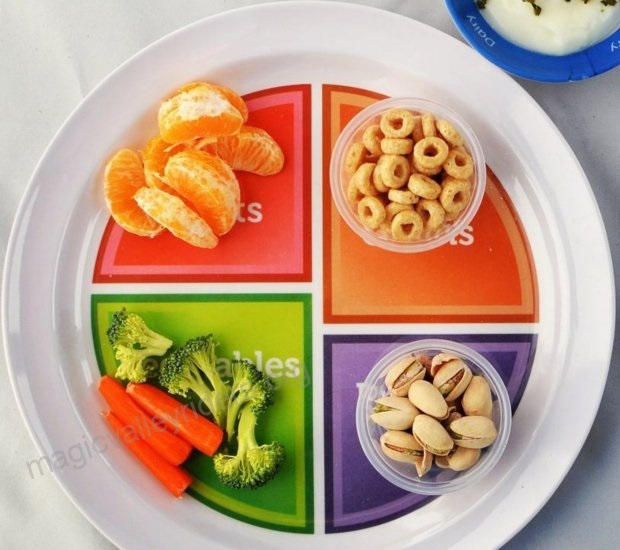
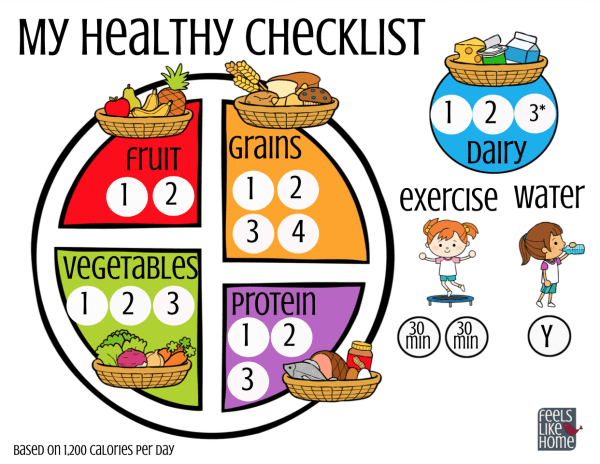
OCTOBER 2018
Breast Cancer Awareness
Each year in the United States, more than 240,000 women get breast cancer and more than 40,000 women die from the disease. Men also get breast cancer, but it is not very common. Less than 1% of breast cancers occur in men.Breast cancer is the most common cancer among American women.
The concerns are even higher for those living with defective BRCA genes. BRCA stands for BR-east CA-ncer. The BRCA genes are designed to produce tumor-suppressing proteins that protect people from developing breast and other cancers by repairing damaged DNA. Mutations in these genes can cause the BRCA proteins to malfunction, resulting in an increased risk of developing cancer, often at a young age, because of the proteins’ inability to perform the repairs.
BRCA and breast cancer risk in women:
The average lifetime risk of breast cancer for BRCA-positive women is 70%, although some studies have found an up to 87 percent risk.1
Women without a BRCA mutation have a 12 percent chance of developing breast cancer during their lifetime.
Unfortunately, these mutations can be passed down from generation to generation; Each child of a parent – either a mother or a father – who carries a mutation in one of these genes has a 50 percent chance of inheriting the mutation. In short, entire families are put at risk of developing an aggressive form of breast and other organ cancers known as inherited BRCA cancers.
Getting mammograms regularly can lower the risk of breast cancer. If you are 50 to 74 years old, be sure to have a screening mammogram every two years. If you are 40 to 49 years old, or have a family history of breast cancer, talk to your doctor about when to start and how often to get a screening mammogram.
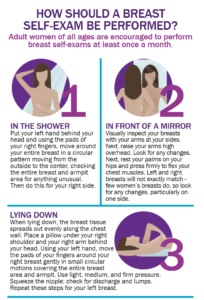
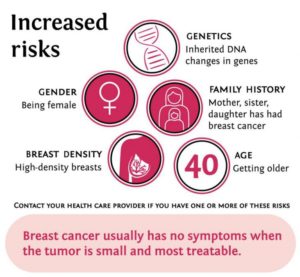
NOVEMBER 2018
Diabetes Awareness
Diabetes is one of the most common causes of disability and death in the United States. Long term effects can include blindness, nerve damage, kidney disease, and other health problems if it’s not controlled.”One in 10 Americans have diabetes — that’s more than 30 million people. And another 84 million adults in the United States are at high risk of developing type 2 diabetes.”(Healthcarefinder.gov) However, people who are at high risk for type 2 diabetes can lower their risk by more than half if they make healthy changes. These changes include: eating healthy, getting more physical activity, and losing weight.
Please also see the infographic below for more information or stop by the primary care office to get your glucose level checked!!
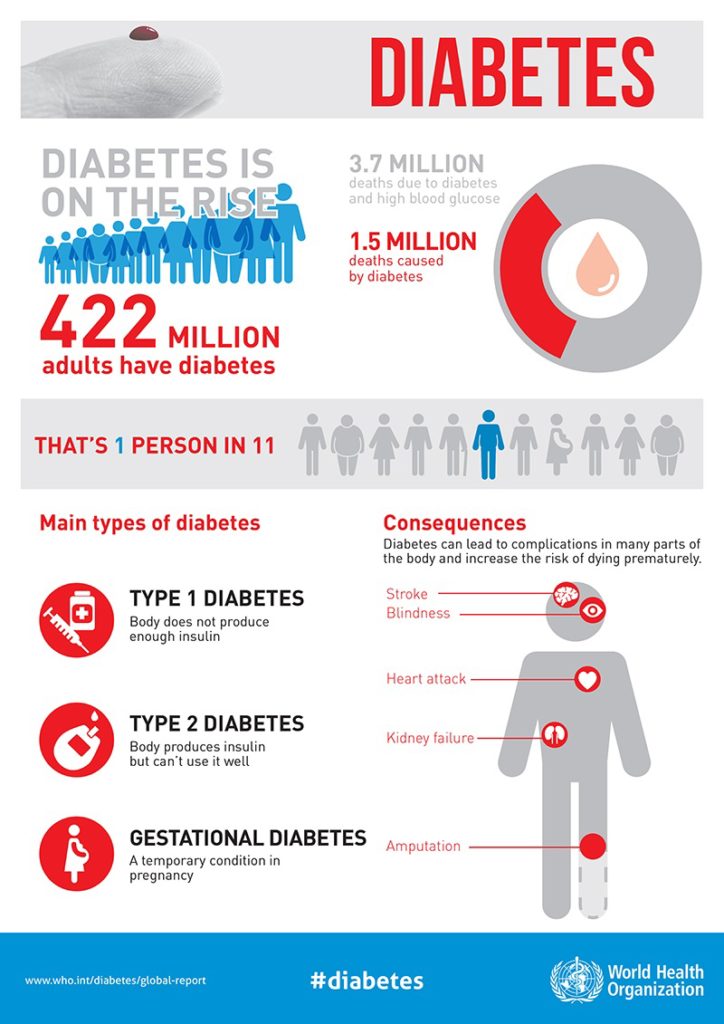
DECEMBER 2018
Handwashing Awareness
December is a busy time for most people. Between the rush of the holidays, the end-of-the-year excitement, and the turn in the weather, it’s easy to become run down and exhausted—perfect conditions for illnesses. When your system is compromised, it’s extra important to stay healthy by avoiding germs, and the best way to do that is by washing your hands. By keeping up with these good habits, you can easily decrease your risk of the flu, viruses, and the common cold.
What is the right way to wash your hands?
Follow the five steps below to wash your hands
the right way every time.
1)Wet your hands with clean, running water (warm or cold), turn off the tap, and apply soap.
2)Lather your hands by rubbing them together with the soap. Be sure to lather the backs of your hands, between your fingers, and under your nails.
3)Scrub your hands for at least 20 seconds. Need a timer? Hum the “Happy Birthday” song from beginning to end twice.
4)Rinse your hands well under clean, running water.
5)Dry your hands using a clean towel or air dry them
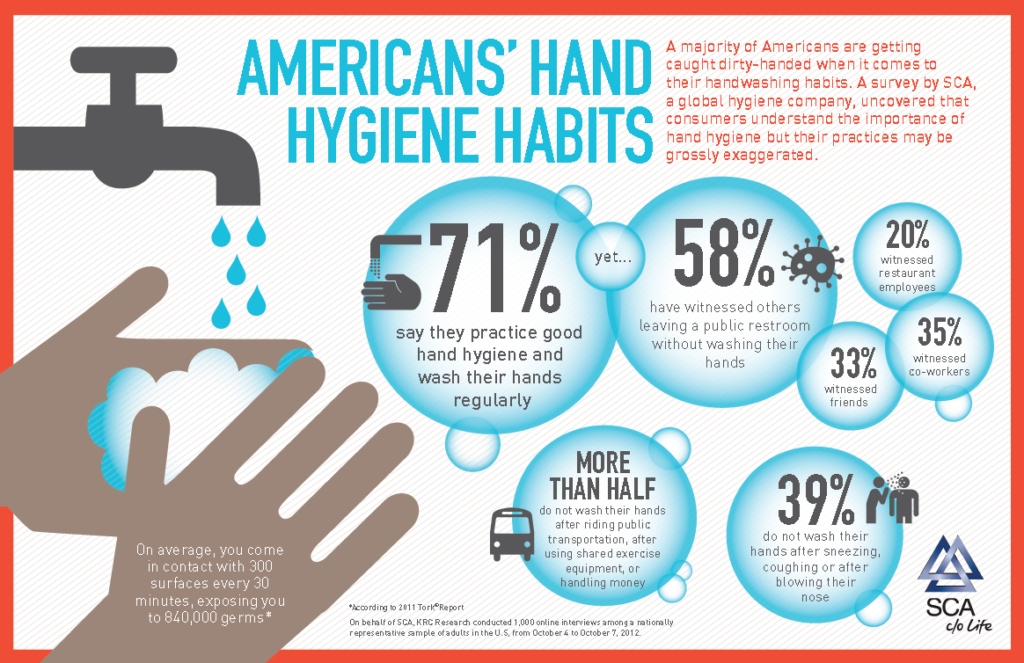
JULY 2018
Eye Injury Awareness
According to the American Academy of Ophthalmology, an estimated 90 percent of eye injuries are preventable with the use of proper safety eyewear. Even a minor injury to the cornea—like that from a small particle of dust or debris—can be painful and become a life-long issue, so take the extra precaution and always protect the eyes. If the eye is injured, seek emergency medical help immediately!!!
When to Wear Protective Eyewear
According to these standards, you (or anyone who is watching you work) should always wear properly fitted eye protective gear, such as safety glasses with side protection/shields, when:
- Doing work that may produce particles, slivers, or dust from materials like wood, metal, plastic, cement, and drywall
- Hammering, sanding, grinding
- Doing masonry work
- Working with power tools
- Working with chemicals including common household chemicals like ammonia, oven cleaners, and bleach
- Using a lawnmower, riding mower, or other motorized gardening devices like string trimmers (also called “weed wacker” or “weed whip”)
- Working with wet or powdered cement
- Welding (which requires extra protection like a welding mask or helmet from sparks and UV radiation)
- “Jumping” the battery of a motor vehicle
- Being a bystander to any of the above
It’s also important to know the signs of eye injury. If you notice any signs on yourself or a co-worker, get medical help right away.
-
- Obvious eye pain or trouble seeing
- A cut or torn eyelid
- One eye not moving as well as the other
- One eye sticking out more than the other
- Unusual pupil size or shape
- Blood in the clear part of the eye
- Something in the eye or under the eyelid that can’t easily be removed
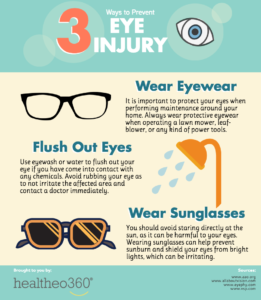
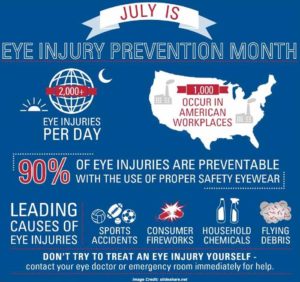
AUGUST 2018
National Opioid Misuse Day
National Opioid Misuse Day is August 31st, 2018!!!
Prescription Opioid Drug Abuse has become a major epidemic in the United States. From 1999 to 2016 more than 12,000 North Carolinians died from opioid-related overdoses. This epidemic is devastating families and communities. Opioids, such as heroin and opioid-based pain medications such as Oxycodone (Percocet), Hydrocodone (Vicodin), and Fentanyl are dangerous substances when used illicitly and/or without a valid reason and prescription.
Recognizing that opioid abuse is a national health epidemic, the AMA Alliance, in collaboration with the American Medical Association, is focusing efforts and attention to educating physicians, families, and our communities about the causes, the dangers, and treatments of opioid abuse and addiction.
Detecting drug abuse early on is the most effective way of preventing an addiction from developing.
To help identify whether someone is battling an opioid abuse problem, there are several physical and behavioral warning signs to watch out for.
The most common physical and behavioral signs of opiate abuse are: Needle marks on arms and legs from intravenous (injected) use constricted, “pinpoint” pupils; Having trouble staying awake, or falling asleep at inappropriate times; Flushed, itchy skin; Withdrawing from social activities that were once enjoyed; Sudden and dramatic mood swings that seem out of character; Impulsive actions and decision-making; Engaging in risky activities, such as driving under the influence; Visiting multiple doctors in order to obtain more prescriptions
SAMHSA’s National Helpline is a free, confidential, 24/7, 365-day-a-year treatment referral and information service (in English and Spanish) for individuals and families facing mental and/or substance use disorders.
SAMHSA’s National Helpline – 1-800-662-HELP (4357)

SEPTEMBER 2018
National Childhood Obesity & National Cholesterol Education Awareness
According to the CDC, about 1 of every 5 (17%) children in the U.S. has obesity. Children with obesity are at higher risk for having other chronic health conditions and diseases, such as asthma, sleep apnea, bone and joint problems, heart disease, high blood pressure, high cholesterol, and type 2 diabetes. They are also more likely to suffer from social isolation, depression, and lower self-esteem.
Childhood obesity is influenced by many factors.
- too much time spent being inactive
- lack of sleep
- lack of places to go in the community to get physical activity
- easy access to inexpensive, high-calorie foods and sugary beverages
- lack of access to affordable, healthier foods
State and local health departments, businesses, and community groups can:
Ensure that neighborhoods have low-cost physical activity opportunities such as parks, trails, and community centers.
Offer easy access to safe, free drinking water and healthy, affordable food options.
Health Care Providers can:
Measure children’s weight, height and body mass index routinely.
Connect or refer families to nutrition education, or childhood healthy weight programs as needed
***********************************
September is National Cholesterol Education Month, a good time to get your blood cholesterol checked and take steps to lower it if it is high.
What is cholesterol?
Cholesterol is a fat-like substance found in your body and many foods. Too much cholesterol can build up in your arteries. After a while, these deposits narrow your arteries, putting you at risk for heart disease and stroke.
Doctors can do a simple blood test called a lipoprotein profile that measures your total cholesterol levels, including LDL (low-density lipoprotein, or “bad” cholesterol), HDL (high-density lipoprotein, or “good” cholesterol), and triglycerides to check your cholesterol. High cholesterol can be controlled through lifestyle changes or if it is not enough, through medications.
If you have high cholesterol, what can you do to lower it?
Low-fat and high-fiber food (Eat more fresh fruits, fresh vegetables, and whole grains). For adults, getting at least 2 hours and 30 minutes of moderate or 1 hour and 15 minutes of physical activity a week. For those aged 6-17, getting 1 hour or more of physical activity each day.
Maintain a healthy weight.
Don’t smoke or
quit if you smoke.
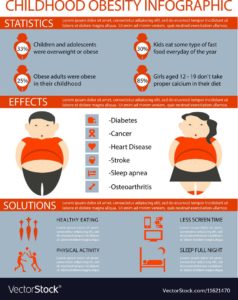
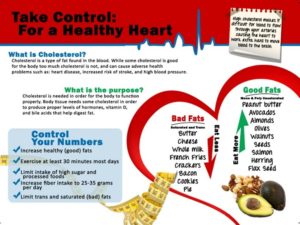
April 2018
Alcohol Awareness
Alcohol is the most commonly used addictive substance in the United States. The National Council on Alcoholism and Drug Dependence, Inc. (NCADD) has sponsored Alcohol Awareness Month to increase public awareness and understanding, reduce stigma and encourage individuals and local communities to focus on alcoholism and alcohol-related problems.
NCADD website reports 17.6 million people, or one in every 12 adults, suffer from alcohol abuse or dependence, along with several million more who engage in risky, binge drinking patterns that could lead to alcohol problems. More than half of all adults have a family history of alcoholism or problem drinking, and more than 7 million children live in a household where at least one parent is dependent on or has abused alcohol.
Here are a few ways that
you can make a positive
difference:
Start with yourself. Be conscientious about your own thoughts, beliefs, and attitude regarding drinking and addiction. Read up on the negative impact drinking can have on your body, mind, health, finances, relationships, and more. Make it a point to be aware of how much and how often you drink, why you drink, and how it affects your life. Also, consider the ways in which you talk about alcohol and alcoholism; what impression are you giving?
Talk to your family. Breaking down stigmas and raising awareness starts in your own home. It’s never too early to begin educating your children about making healthy choices, dealing with stress in constructive ways, and learning how to say no. Use books, movies, news stories, and community outings to initiate conversation. Teach them about the dangerous effects drinking can have as well.
Share your story. There are so many ways to do this: write a blog, write a guest post for the newspaper, speak up when you hear someone sharing misinformation, or be a source of support for someone struggling with addiction or making strides in recovery. Whether you’re speaking to one person or a thousand people, your story matters. You never know whose life you’ll touch.
Attend community events. Show your support by participating in alcohol awareness or addiction recovery events in your community. Join forces with others who are also fighting for the same cause and learn even more as you go along. Networking can go a long way, as can being visible in showing support for a cause.
Host an event. If you’re feeling motivated or inspired, host your own awareness event. Perhaps you could offer to speak at a school, community organization, or other outreach efforts. Talk to others and share your ideas to create a more robust activity.
Seek treatment. Set a positive example and show that treatment does work and recovery is possible by seeking help if you’re struggling with an alcohol use disorder. Or, encourage a loved one to enter treatment and make their well-being a priority.
MAY 2018
National Stroke Awareness
A stroke is an emergency – it can happen to anyone, at any time, and at any age.
The purpose of National Stroke Awareness Month is to make Americans aware that they may be able to ‘Save A Life’ of a person experiencing a stroke.
The National Stroke Awareness Month program places emphasis on making the public aware about Acting FAST.
According to the National Stroke Association, a person experiencing a stroke can be treated if people have acted FAST – 80% of strokes can also be prevented.
FAST is an acronym for
things to check in a
suspected stroke victim:
F – Face / Does the face
droop on one side when
the person smiles?
A – Arm / After raising both
arms, does one of the
arms drift downwards?
S – Speech /After repeating
a simple phrase, does the
persons speech sound
slurred or strange?
T – Time / If any or all of
the above are observed
call for 9-1-1 and ask
for medical assistance.
Please watch this
informative video to learn
more.
JUNE 2018
PTSD Awareness
PTSD, or Post-Traumatic Stress Disorder, is an anxiety problem that develops in some people after extremely traumatic events, such as combat, crime, an accident or natural disaster.
People with PTSD may relive the event through memories, flashbacks, and nightmares.
MYTH: PTSD only affects war veterans.
FACT: PTSD can affect anyone. Almost 70 percent of Americans will be exposed to a traumatic event in their lifetime. Victims of trauma related to physical and sexual assault face the greatest risk of developing PTSD. Women are about twice as likely to develop PTSD as men. Victims of domestic violence and child abuse are at tremendous risk for PTSD.
MYTH: People suffer from PTSD right after they experience a traumatic event.
FACT: PTSD symptoms usually develop within the first three months after the trauma, but may not appear until months or years have passed. These symptoms may continue for years following the trauma, or, in some cases, symptoms may subside and reoccur later in life, which is often the case with victims of childhood abuse.
Treatment
If diagnosed, there are a number of effective approaches to PTSD treatment. Treatment can involve psychotherapy(Cognitive Behavior Therapy), medication, or a combination of both.
Where to Get Help for PTSD if in crisis?
You have options:
Call 911
Go to the nearest Emergency Room
Call the Suicide Prevention Lifeline 1-800-273-8255
Contact the Veterans Crisis Line: 1-800-273-8255, press 1 (text 838255) or Confidential Veterans Chat with a counselor
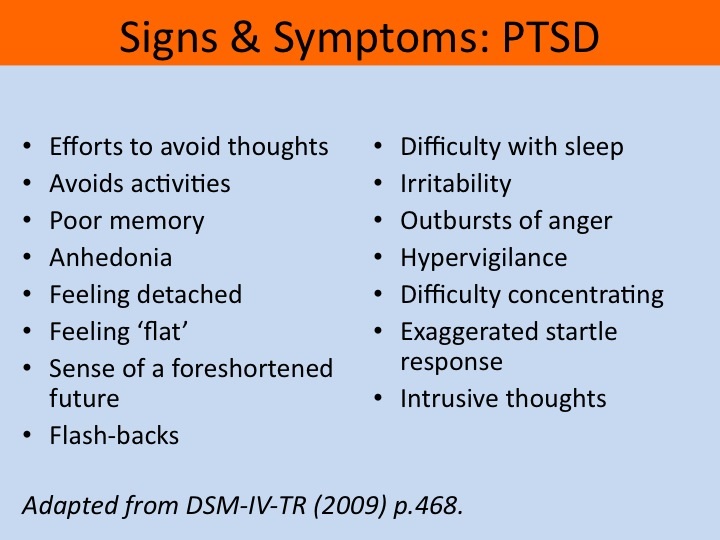

JANUARY 2018
Thyroid Awareness
The thyroid gland is a small, butterfly-shaped gland located in the lower front of the neck. Your thyroid gland makes hormones that help control the function of many of your body’s organs y(our heart, brain, liver, kidneys, and skin). Making sure that your thyroid gland is healthy is important to your body’s overall well-being.
There are two types of thyroid problems. Hyperthyroidism develops when the body is exposed to excessive amounts of thyroid hormone. Symptoms of hyperthyroidism include fast heart rate, trembling hands weight loss, intolerance of warm temperatures, loss of scalp hair, a tendency of fingernails to separate from the nail bed, and muscle weakness. An underactive thyroid, or hypothyroidism, occurs when the thyroid gland produces less than the normal amount of thyroid hormone. Symptoms of hypothyroidism are fatigue, drowsiness, forgetfulness, difficulty learning, sore muscles, weight gain, and fluid retention.
According to thyroidawareness.com, an estimated 15 million of Americans have undiagnosed thyroid problems. To help with early detection and in some cases help you find lumps or enlargements in the neck that may point to a thyroid condition, you can perform a simple Neck Check self-exam. Instructions on how to perform a Neck Check Exam are attached to this email or ask your doctor for a blood test.
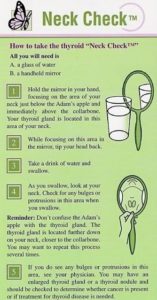
FEBRUARY 2018
American Heart Awareness
Heart disease is the leading cause of death in the United States; one in every three deaths is from heart disease and stroke, equal to 2,200 deaths per day.
You can make healthy changes to lower your risk of developing heart disease. Controlling and preventing risk factors is also important for people who already have heart disease. To lower your risk:
Eat healthy.
Get active.
Stay at a healthy weight.
Quit smoking and stay away from secondhand smoke.
Control your cholesterol and blood pressure.
If you drink alcohol, drink only in moderation.
Manage stress.
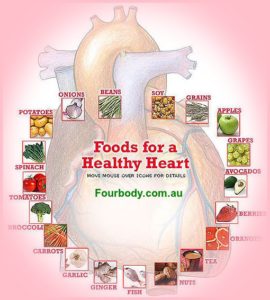
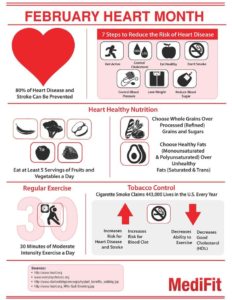
MARCH 2018
Colon Cancer Awareness
In 2018, more than 135,000 people will be diagnosed with this highly preventable disease. They will join more than 1.4 million colorectal cancer patients and survivors living today. We go blue for them and their families.
Colon cancer risk factors include a personal history of colorectal cancer, polops, or inflammatory bowel disease (ulcerative colitis or Crohn’s disease), obesity, type 2 diabetes, smoking, eating frequent red meats, drinking alcohol, low levels of vitamin D, and being 50 years or older.
When should I have a colonoscopy?
If you have no colorectal symptoms, family history of colon cancer, polyps or inflammatory bowel disease you should have your first exam at age 50.
If one or more first degree relative (parent, sibling or child) has had a precancerous polyp or colon cancer, the general guideline is to begin colon cancer screening 10 years younger than the youngest age of the family member with colon cancer, or age 40, whichever is younger. There are additional guidelines for suspected or confirmed rare syndromes, and you should discuss these options with your doctor.
Five Nutritional Tips for Colon Cancer Prevention
For patients with ulcerative colitis involving the entire colon and patients with Crohn’s disease, screening for colon cancer should begin 8 – 10 years after the initial diagnosis is made.
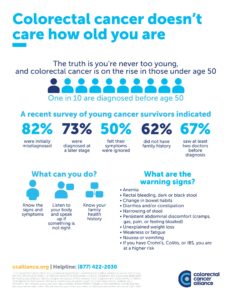
OCTOBER 2017
Mental Health Awareness
Know the Warning Signs
MENTAL ILLNESS
- ADHD
- Anxiety Disorders
- Autism
- Bipolar Disorder
- Borderline Personality Disorder
- Depression
- Dissociative Disorders
- Eating Disorders
- Obsessive-Compulsive Disorder
- Posttraumatic Stress Disorder
- Schizoaffective Disorder
- Schizophrenia
RELATED CONDITIONS

The following are Mental Health screening tests:
- The Depression Test is for individuals who are feeling an overwhelming sadness.
- The Anxiety Test will help if you feel that worry and fear affect your day to day life.
- The Bipolar Test is for individuals who have mood swings – or unusual or extreme shifts in mood and energy.
- The PTSD (Post Traumatic Stress Disorder) Test is for those who are bothered by a traumatic life event.
- The Work Health Survey is a screen to explore how healthy or unhealthy your work environment is. It is in a testing phase and every screen taken helps us better understand mental health in the workplace.
- The Alcohol or Substance Use Test will help determine if your use of alcohol or drugs is an area to address.
- The Youth Test is for young people (age 11-17) who are concerned that their emotions, attention, or behaviors might be signs of a problem.
- The Parent Test is for parents of young people to determine if their child’s emotions, attention, or behaviors might be signs of a problem.
- The Psychosis Test is for young people (age 12-35) who feel like their brain is playing tricks on them (seeing, hearing or believing things that don’t seem real or quite right).
- The Eating Disorder Test can help explore eating-related concerns that have an impact on your physical health and overall well-being.
NOVEMBER 2017
Diabetes Awareness
Diabetes is one of the most common causes of disability and death in the United States. Long-term effects can include blindness, nerve damage, kidney disease, and other health problems if it’s not controlled.”One in 10 Americans have diabetes — that’s more than 30 million people. And another 84 million adults in the United States are at high risk of developing type 2 diabetes.”(Healthcarefinder.gov) However, people who are at high risk for type 2 diabetes can lower their risk by more than half if they make healthy changes. These changes include: eating healthy, getting more physical activity, and losing weight.
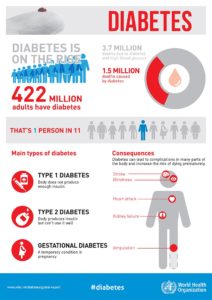
DECEMBER 2017
Handwashing Awareness
December is a busy time for most people. Between the rush of the holidays, the end-of-the-year excitement, and the turn in the weather, it’s easy to become run down and exhausted—perfect conditions for illnesses. When your system is compromised, it’s extra important to stay healthy by avoiding germs, and the best way to do that is by washing your hands. By keeping up with these good habits, you can easily decrease your risk of the flu, viruses, and the common cold.
What is the right way to wash your hands?
Follow the five steps below to wash your hands the right way every time.
1)Wet your hands with clean, running water (warm or cold), turn off the tap, and apply soap.
2)Lather your hands by rubbing them together with the soap. Be sure to lather the backs of your hands, between your fingers, and under your nails.
3)Scrub your hands for at least 20 seconds. Need a timer? Hum the “Happy Birthday” song from beginning to end twice.
4)Rinse your hands well under clean, running water.
5)Dry your hands using a clean towel or air dry them
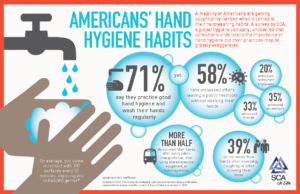
AUGUST 2017
Immunization Awareness
SEPTEMBER 2017
Suicide Prevention Awareness

